A Facile Centrifuge Coating Method for High-Performance CsPbBr3 Compact and Crack-Free Nanocrystal Thin Film Photodetector
Abstract
:1. Introduction
2. Materials and Methods
3. Results and Discussion
4. Conclusions
Author Contributions
Funding
Institutional Review Board Statement
Informed Consent Statement
Data Availability Statement
Conflicts of Interest
References
- Ji, K.; Yuan, J.; Li, F.; Shi, Y.; Ling, X.; Zhang, X.; Zhang, Y.; Lu, H.; Yuan, J.; Ma, W. High-efficiency perovskite quantum dot solar cells benefiting from a conjugated polymer-quantum dot bulk heterojunction connecting layer. J. Mater. Chem. A 2020, 8, 8104–8112. [Google Scholar] [CrossRef]
- Wang, H.; Zhang, X.; Wu, Q.; Cao, F.; Yang, D.; Shang, Y.; Ning, Z.; Zhang, W.; Zheng, W.; Yan, Y.; et al. Trifluoroacetate induced small-grained CsPbBr3 perovskite films result in efficient and stable light-emitting devices. Nat. Commun. 2019, 10, 665. [Google Scholar] [CrossRef] [PubMed] [Green Version]
- Liu, H.; Zhang, X.; Zhang, L.; Yin, Z.; Wang, D.; Meng, J.; Jiang, Q.; Wang, Y.; You, J. A high-performance photodetector based on an inorganic perovskite–ZnO heter-ostructure. J. Mater. Chem. C 2017, 5, 6115–6122. [Google Scholar] [CrossRef]
- Saeed, M.A.; Kim, S.H.; Kim, H.; Liang, J.; Woo, H.Y.; Kim, T.G.; Yan, H.; Shim, J.W. Indoor Organic Photovoltaics: Optimal Cell Design Principles with Synergistic Parasitic Resistance and Optical Modulation Effect. Adv. Energy Mater. 2021, 11, 2003103. [Google Scholar] [CrossRef]
- Saeed, M.A.; Cheng, S.; Biswas, S.; Kim, S.H.; Kwon, S.-K.; Kim, H.; Kim, Y.-H.; Shim, J.W. Remarkably high performance of organic photovoltaic devices with 3,9-bis(2-methylene- (3-(1,1-dicyanomethylene)-indanone))-5,5,11,11-tetrakis(4-hexyl meta-phenyl)-dithieno[2,3-d:2′,3′-d′]-s-indaceno[1,2-b:5,6-b′]dithiophene)-ethylhexyloxy] photoactive acceptor under halogen light illumination. J. Power Sources 2021, 518, 230782. [Google Scholar] [CrossRef]
- Saeed, M.A.; Yoo, K.; Kang, H.C.; Shim, J.W.; Lee, J.-J. Recent developments in dye-sensitized photovoltaic cells under ambient illumination. Dye. Pigment. 2021, 194, 109626. [Google Scholar] [CrossRef]
- Wu, T.; Qin, Z.; Wang, Y.; Wu, Y.; Chen, W.; Zhang, S.; Cai, M.; Dai, S.; Zhang, J.; Liu, J.; et al. The Main Progress of Perovskite Solar Cells in 2020–2021. Nano-Micro Lett. 2021, 13, 152. [Google Scholar] [CrossRef]
- Zhang, H.; Fu, X.; Tang, Y.; Wang, H.; Zhang, X.; Yu, W.; Wang, X.; Zhang, Y.; Xiao, M. Phase segregation due to ion migration in all-inorganic mixed-halide perovskite nanocrystals. Nat Commun. 2019, 10, 1088. [Google Scholar] [CrossRef] [Green Version]
- Wang, Y.; Quintana, X.; Kim, J.; Guan, X.; Hu, L.; Lin, C.-H.; Jones, B.T.; Chen, W.; Wen, X.; Gao, H.; et al. Phase segregation in inorganic mixed-halide perovskites: From phenomena to mechanisms. Photon-Res. 2020, 8, A56–A71. [Google Scholar] [CrossRef]
- Li, X.; Wu, Y.; Zhang, S.; Cai, B.; Gu, Y.; Song, J.; Zeng, H. CsPbX3 Quantum Dots for Lighting and Displays: Room Tempera-ture Synthesis, Photoluminescence Superiorities, Underlying Origins and White Light-Emitting Diodes. Adv. Funct. Mater. 2016, 26, 2435–2445. [Google Scholar] [CrossRef]
- Suh, Y.H.; Kim, T.; Choi, J.W.; Lee, C.L.; Park, J. High-Performance CsPbX3 Perovskite Quantum-Dot Light-Emitting Devices via Solid-State Ligand Exchange. ACS Appl. Nano Mater. 2018, 1, 488–496. [Google Scholar] [CrossRef]
- Chaudhary, B.; Kshetri, Y.K.; Kim, H.-S.; Lee, S.W.; Kim, T.-H. Current status on synthesis, properties and applications of CsPbX3 (X = Cl, Br, I) perovskite quantum dots/nanocrystals. Nanotechnology 2021, 32, 502007. [Google Scholar] [CrossRef] [PubMed]
- Swarnkar, A.; Marshall, A.R.; Sanehira, E.M.; Chernomordik, B.D.; Moore, D.T.; Christians, J.A.; Chakrabarti, T.; Luther, J.M. Quantum dot-induced phase stabilization of α-CsPbI3 perovskite for high-efficiency photovoltaics. Science 2016, 354, 92–95. [Google Scholar] [CrossRef] [PubMed] [Green Version]
- Hao, M.; Bai, Y.; Zeiske, S.; Ren, L.; Liu, J.; Yuan, Y.; Zarrabi, N.; Cheng, N.; Ghasemi, M.; Chen, P.; et al. Ligand-assisted cation-exchange engineering for high-efficiency colloidal Cs1−xFAxPbI3 quantum dot solar cells with reduced phase segregation. Nat. Energy 2020, 5, 79–88. [Google Scholar] [CrossRef]
- Kim, G.; Min, H.; Lee, K.S.; Lee, D.Y.; Yoon, S.M.; Seok, S.I. Impact of strain relaxation on performance of α-formamidinium lead iodide perovskite solar cells. Science 2020, 370, 108–112. [Google Scholar] [CrossRef]
- Wang, C.; Chesman, A.S.R.; Yin, W.; Frazer, L.; Funston, A.M.; Jasieniak, J.J. Facile purification of CsPbX3 (X = Cl−, Br−, I−) perovskite nanocrystals. J. Chem. Phys. 2019, 151, 121105. [Google Scholar] [CrossRef]
- Yang, T.; Zhang, Z.; Ding, Y.; Yin, N.; Liu, X. Nondestructive purification process for inorganic perovskite quantum dot solar cells. J. Nanoparticle Res. 2019, 21, 101. [Google Scholar] [CrossRef]
- Zhao, Q.; Hazarika, A.; Chen, X.; Harvey, S.P.; Larson, B.W.; Teeter, G.R.; Liu, J.; Song, T.; Xiao, C.; Shaw, L.; et al. High efficiency perovskite quantum dot solar cells with charge separating hetero-structure. Nat. Commun. 2019, 10, 2842. [Google Scholar] [CrossRef]
- Yang, Z.; Wang, M.; Li, J.; Dou, J.; Qiu, H.; Shao, J. Spray-Coated CsPbBr3 Quantum Dot Films for Perovskite Photodiodes. ACS Appl. Mater. Interfaces 2018, 10, 26387–26395. [Google Scholar] [CrossRef]
- Hamukwaya, S.; Hao, H.; Zhao, Z.; Dong, J.; Zhong, T.; Xing, J.; Hao, L.; Mashingaidze, M. A Review of Recent Developments in Preparation Methods for Large-Area Perovskite Solar Cells. Coatings 2022, 12, 252. [Google Scholar] [CrossRef]
- Fan, T.; Lü, J.; Chen, Y.; Yuan, W.; Huang, Y. Random lasing in cesium lead bromine perovskite quantum dots film. J. Mater. Sci. Mater. Electron. 2018, 30, 1084–1088. [Google Scholar] [CrossRef]
- Algadi, H.; Mahata, C.; Woo, J.; Lee, M.; Kim, M.; Lee, T. Enhanced Photoresponsivity of All-Inorganic (CsPbBr3) Perovskite Nanosheets Photodetector with Carbon Nanodots (CDs). Electronics 2019, 8, 678. [Google Scholar] [CrossRef] [Green Version]
- Zhou, L.; Yu, K.; Yang, F.; Zheng, J.; Zuo, Y.; Li, C.; Cheng, B.; Wang, Q. All-inorganic perovskite quantum dot/mesoporous TiO2 composite-based photodetectors with enhanced performance. Dalton Trans. 2017, 46, 1766–1769. [Google Scholar] [CrossRef] [PubMed]
- Dong, Y.; Gu, Y.; Zou, Y.; Song, J.; Xu, L.; Li, J.; Xue, J.; Li, X.; Zeng, H. Improving All-Inorganic Perovskite Photodetectors by Preferred Orientation and Plasmonic Effect. Small 2016, 12, 5622–5632. [Google Scholar] [CrossRef] [PubMed]
- Yan, S.; Li, Q.; Zhang, X.; Tang, S.; Lei, W.; Chen, J. A vertical structure photodetector based on all-inorganic perovskite quantum dots. J. Soc. Inf. Disp. 2020, 28, 9–15. [Google Scholar] [CrossRef]
- Shin, H.; Oytun, F.; Kim, J.; Lee, B.; Kim, J.; Basarir, F.; Choi, H. Cost-effective centrifuge coating method for silver nanowire-based transparent conducting electrode. Electrochim. Acta 2020, 337, 135839. [Google Scholar] [CrossRef]
- Huang, Y.Y.S.; Terentjev, E.M. Transparent nanostructured electrode by centrifuge coating. In Proceedings of the 2012 12th IEEE International Conference on Nanotechnology (IEEE-NANO), Birmingham, UK, 20–23 August 2012; pp. 1–4. [Google Scholar]
- Kim, Y.; Yassitepe, E.; Voznyy, O.; Comin, R.; Walters, G.; Gong, X.; Kanjanaboos, P.; Nogueira, A.F.; Sargent, E.H. Efficient Luminescence from Perovskite Quantum Dot Solids. ACS Appl. Mater. Interfaces 2015, 7, 25007–25013. [Google Scholar] [CrossRef]
- Protesescu, L.; Yakunin, S.; Bodnarchuk, M.; Krieg, F.; Caputo, R.; Hendon, C.; Yang, R.; Walsh, A.; Kovalenko, M. Nano-crystals of Cesium Lead Halide Perovskites (CsPbX3, X = Cl, Br, and I): Novel Optoelectronic Materials Showing Bright Emission with Wide Color Gamut. Nano Lett. 2015, 15, 3692–3696. [Google Scholar] [CrossRef] [Green Version]
- Chen, L.-C.; Tien, C.-H.; Tseng, P.-W.; Tseng, Z.-L.; Huang, W.-L.; Xu, Y.-X.; Kuo, H.-C. Effect of Washing Solvents on the Properties of Air-Synthesized Perovskite CsPbBr3 Quantum Dots for Quantum Dot-Based Light-Emitting Devices. IEEE Access 2020, 8, 159415–159423. [Google Scholar] [CrossRef]
- Nguyen, T.T.T.; Luu, T.N.; Nguyen, D.H.; Duong, T.T. Comparative Study on Backlighting Unit Using CsPbBr3 Nanocrystals/KSFM Phosphor + Blue LED and Commercial WLED in Liquid Crystal Display. J. Electron. Mater. 2021, 50, 1827–1834. [Google Scholar] [CrossRef]
- Li, X.; Yu, D.; Cao, F.; Gu, Y.; Wei, Y.; Wu, Y.; Song, J.; Zeng, H. Healing All-Inorganic Perovskite Films via Recyclable Dissolution-Recyrstallization for Compact and Smooth Carrier Channels of Optoelectronic Devices with High Stability. Adv. Funct. Mater. 2016, 26, 5903–5912. [Google Scholar] [CrossRef]
- Song, J.; Xu, L.; Li, J.; Xue, J.; Dong, Y.; Li, X.; Zeng, H. Monolayer and Few-Layer All-Inorganic Perovskites as a New Family of Two-Dimensional Semiconductors for Printable Optoelectronic Devices. Adv. Mater. 2016, 28, 4861–4869. [Google Scholar] [CrossRef] [PubMed]
- Ding, J.; Du, S.; Zuo, Z.; Zhao, Y.; Cui, H.; Zhan, X. High Detectivity and Rapid Response in Perovskite CsPbBr3 Single-Crystal Photodetector. J. Phys. Chem. C 2017, 121, 4917–4923. [Google Scholar] [CrossRef]
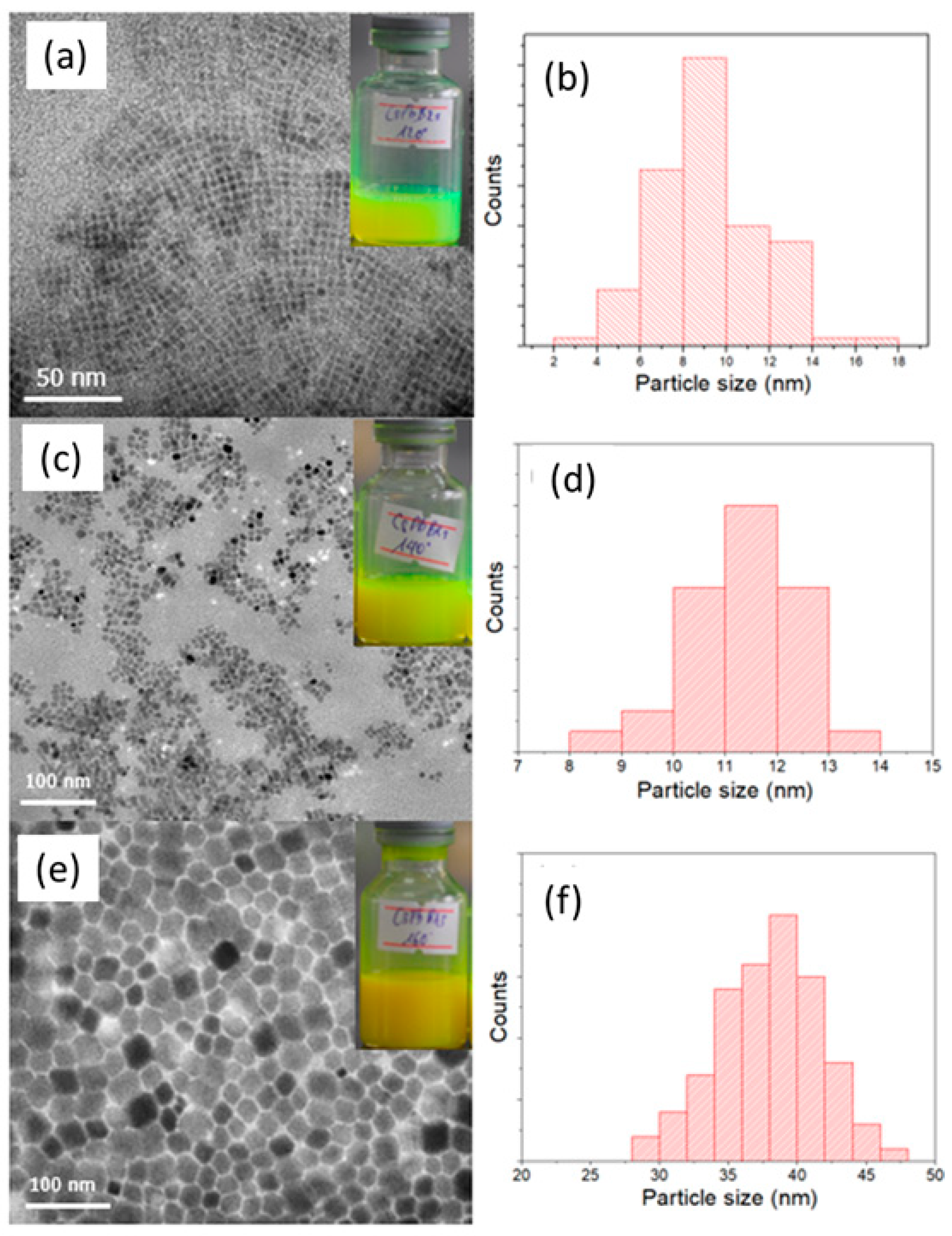
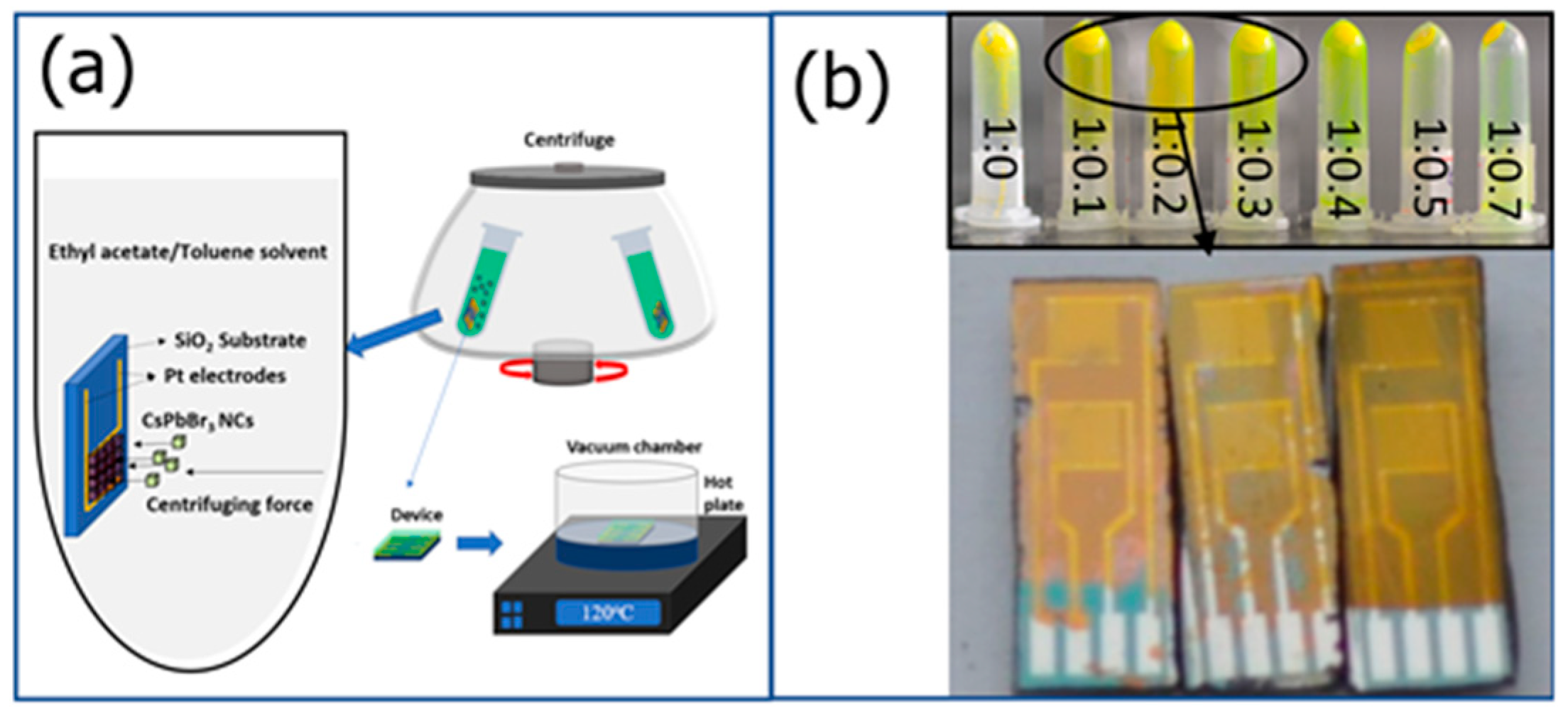
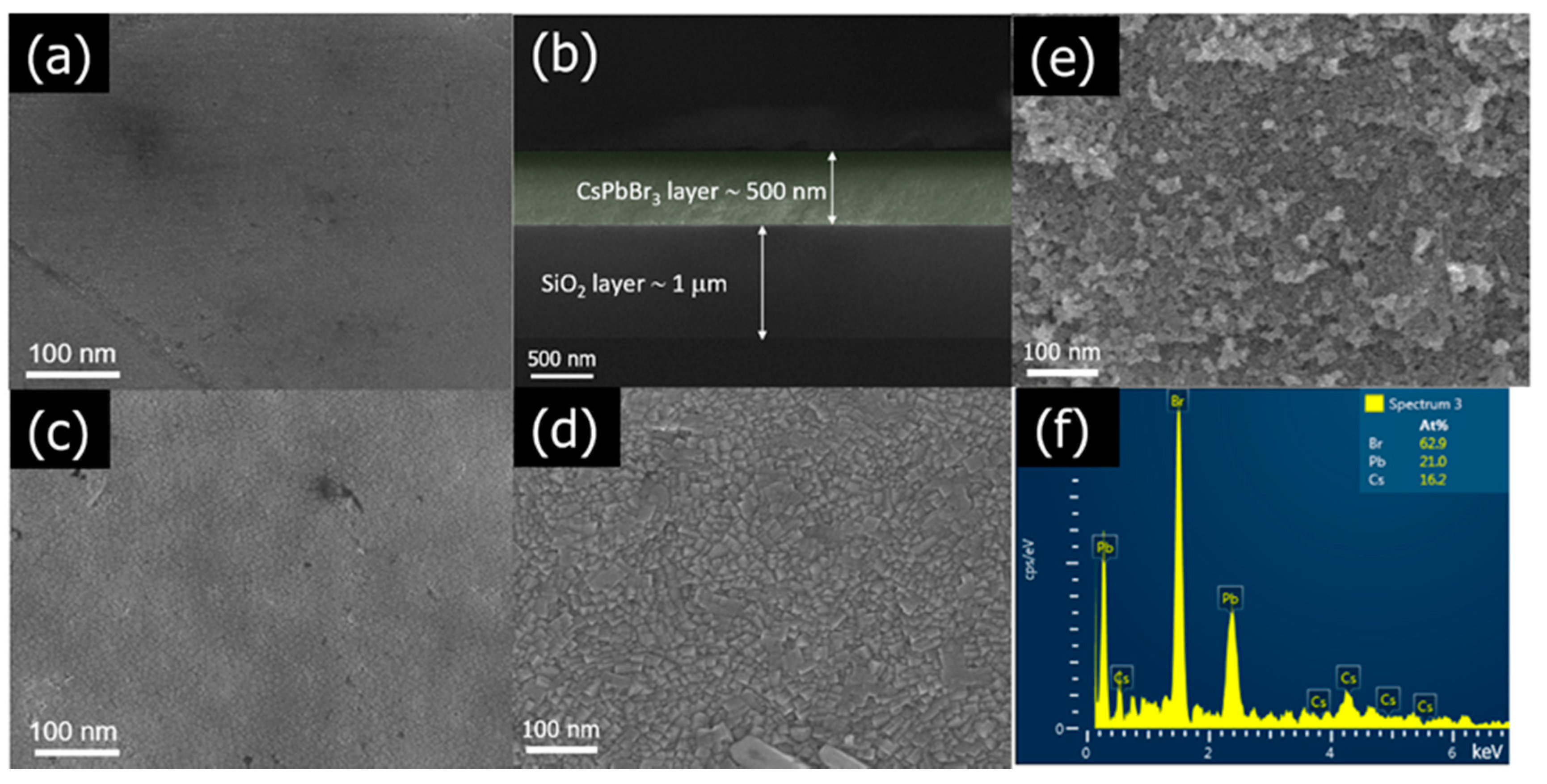
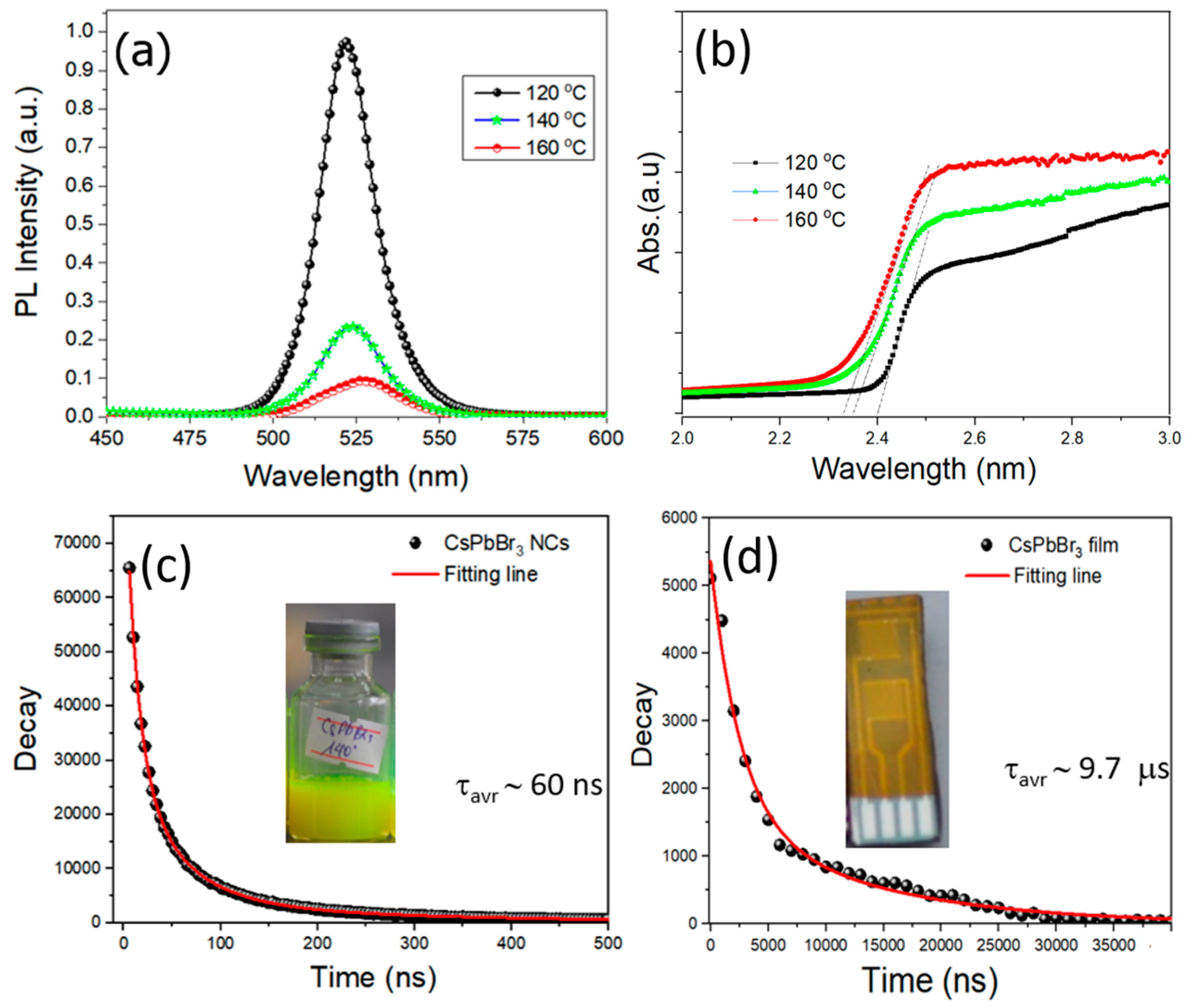
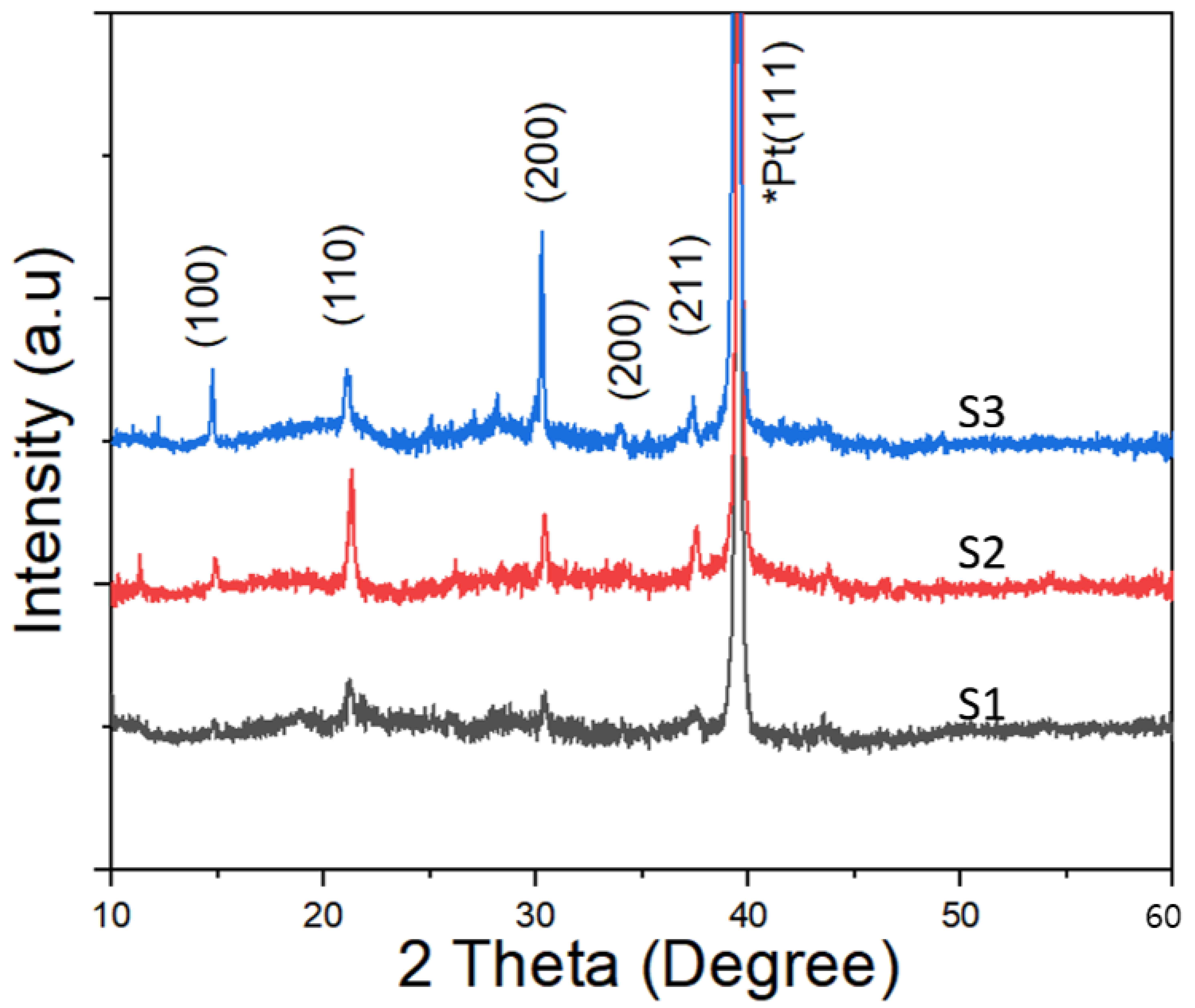
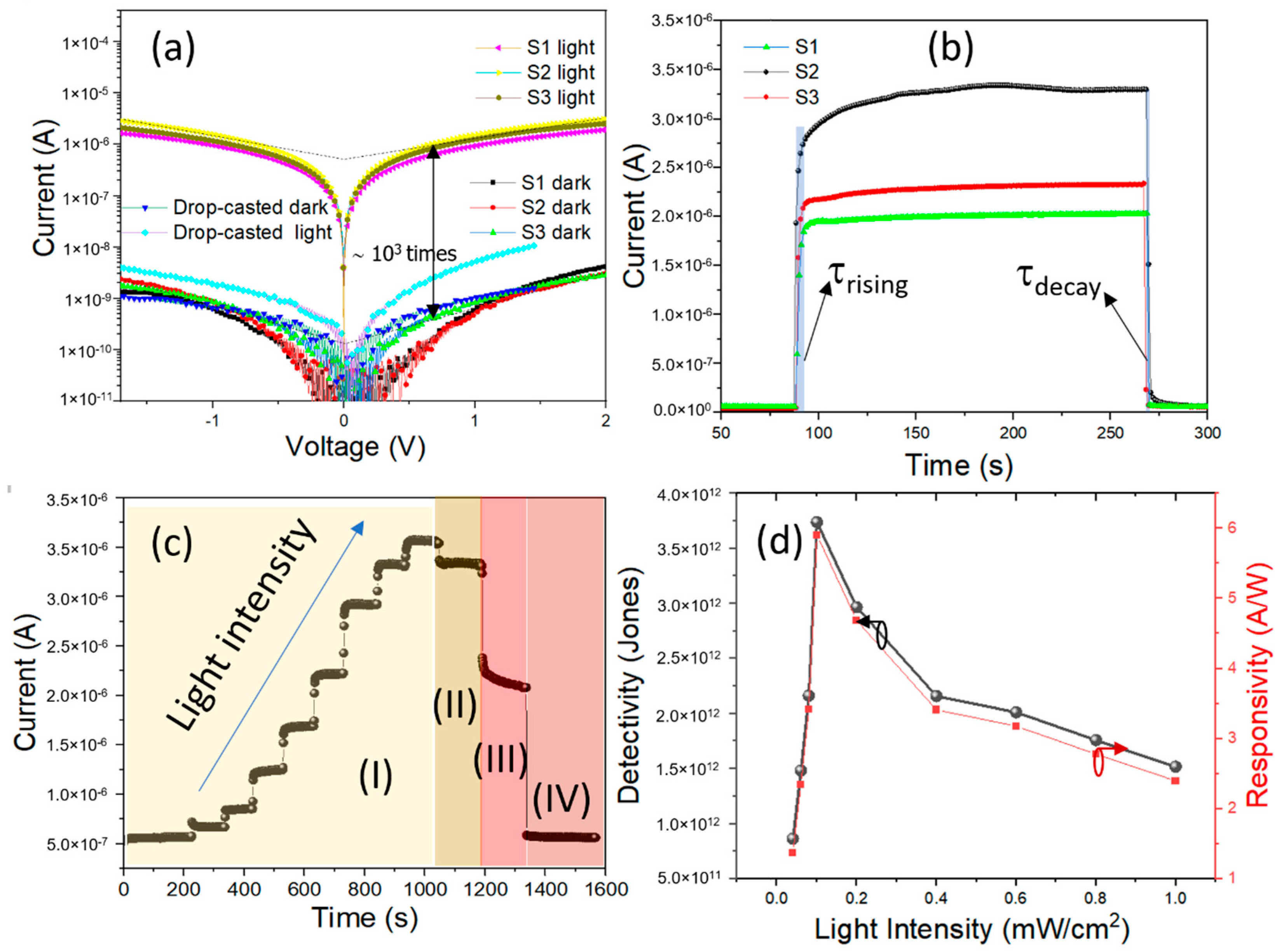
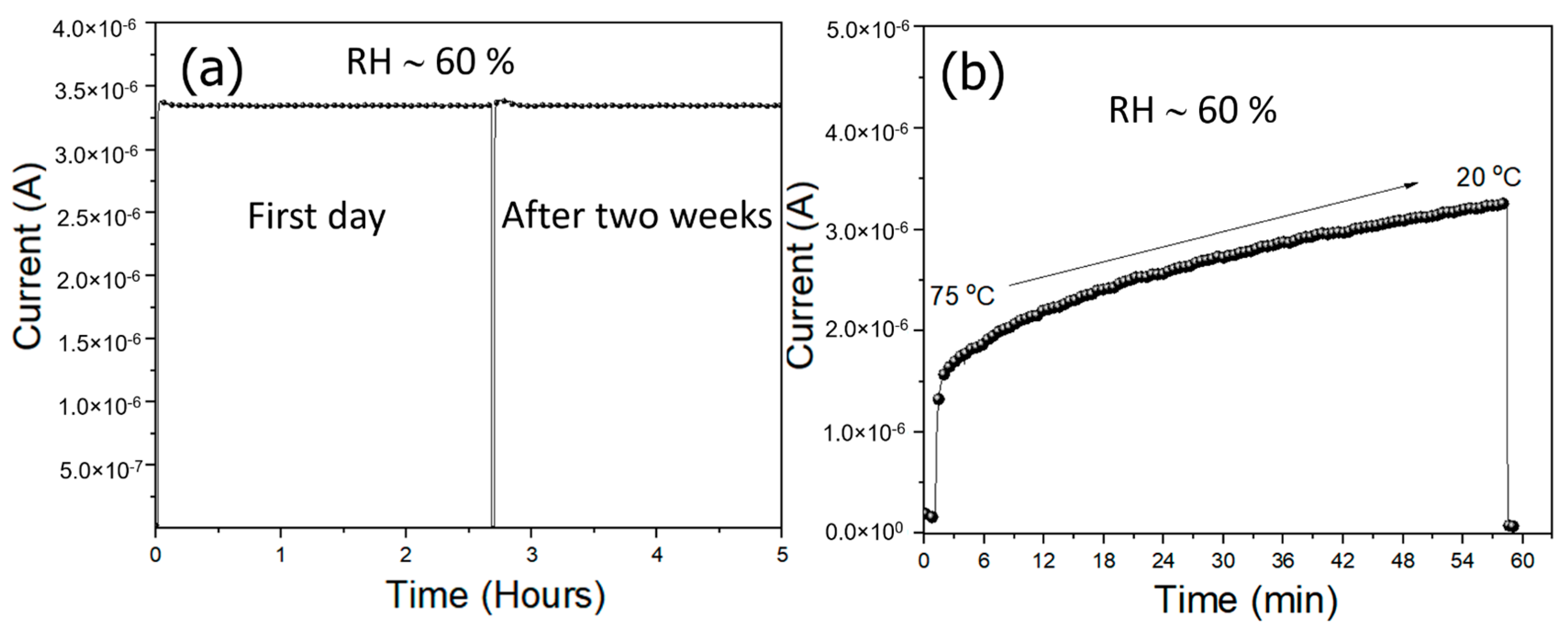
| Active Materials | Wavelength (nm) | Responsivity (A/W) | Rise/Fall (s) | On/Off Ratio | Detectivity (Jones) | Ref |
|---|---|---|---|---|---|---|
| CsPbBr3 QDs | 0.40 mWcm−2 @ 532 nm | 4.7 × 10−3 | 0.2/1.3 | 1.6 × 105 | 16.84 × 108 | [24] |
| CsPbBr3 micro-particles | 1.01 mWcm−2 @ 442 nm | 0.18 | 1.8/1 | 8 × 103 | 6.1 × 1010 | [32] |
| CsPbBr3 nanosheets | 0.35 mWcm−2 @ 442 nm | 0.25 | 0.019/0.025 | 103 | - | [33] |
| Single crystal CsPbBr3 | 1 mW @ 450 nm | 0.028 | 90.7/57 | 102 | 1.8 × 1011 | [34] |
| CsPbBr3 nano crystals film | Halogen lamp 0.1 mW/cm2 | 6.0 | 4/1 | 103 | 3.6 × 1012 | this work |
Publisher’s Note: MDPI stays neutral with regard to jurisdictional claims in published maps and institutional affiliations. |
© 2022 by the authors. Licensee MDPI, Basel, Switzerland. This article is an open access article distributed under the terms and conditions of the Creative Commons Attribution (CC BY) license (https://creativecommons.org/licenses/by/4.0/).
Share and Cite
Tran, P.-N.; Tran, B.-D.; Nguyen, D.-C.; Nguyen, T.-L.; Tran, V.-D.; Duong, T.-T. A Facile Centrifuge Coating Method for High-Performance CsPbBr3 Compact and Crack-Free Nanocrystal Thin Film Photodetector. Crystals 2022, 12, 587. https://doi.org/10.3390/cryst12050587
Tran P-N, Tran B-D, Nguyen D-C, Nguyen T-L, Tran V-D, Duong T-T. A Facile Centrifuge Coating Method for High-Performance CsPbBr3 Compact and Crack-Free Nanocrystal Thin Film Photodetector. Crystals. 2022; 12(5):587. https://doi.org/10.3390/cryst12050587
Chicago/Turabian StyleTran, Phuong-Nam, Ba-Duc Tran, Duy-Cuong Nguyen, Thi-Lan Nguyen, Van-Dang Tran, and Thanh-Tung Duong. 2022. "A Facile Centrifuge Coating Method for High-Performance CsPbBr3 Compact and Crack-Free Nanocrystal Thin Film Photodetector" Crystals 12, no. 5: 587. https://doi.org/10.3390/cryst12050587
APA StyleTran, P.-N., Tran, B.-D., Nguyen, D.-C., Nguyen, T.-L., Tran, V.-D., & Duong, T.-T. (2022). A Facile Centrifuge Coating Method for High-Performance CsPbBr3 Compact and Crack-Free Nanocrystal Thin Film Photodetector. Crystals, 12(5), 587. https://doi.org/10.3390/cryst12050587





